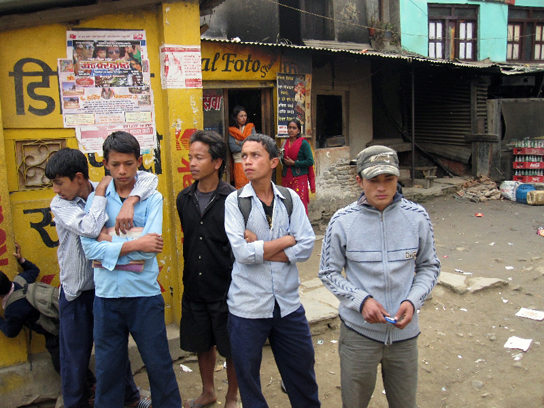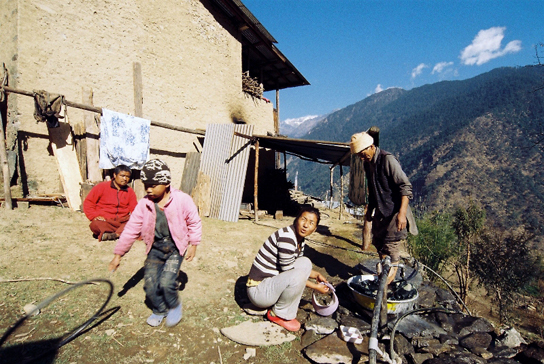(This is another post that comes from my invitation to all of you to send me two of your pictures to get my thoughts on them. Send two photos at 544 pixels/72 dpi to me at tekamah at me dot com And explain something about the photos and something about your quandary with the two.)
Louis Hebert went to Nepal for a month to help an NGO by making pictures. While there he spent time getting to know and photographing a small group of Sherpa.
Here are his two pictures:

 Both photos © Louis Herbert
Both photos © Louis Herbert
Louis says: “The picture of a group of boys waiting with a bus driver for their bus to arrive is a simple and common village scene. Simple, yet their faces perfectly encapsulate the general ambivalence that permeates the villages as they all wait for modernity to arrive.”
And: “The second shot is of an average morning in a tiny village on the side of a Himalayan mountain. There is a Buddhist monk, a small child enjoying winter break, a young girl that's recently graduated from college, and a grandfather contentedly plugging away at the day's chores. This image humanizes them. It shows us that Sherpa are not just about carrying heavy loads, but that they are people plugging along just like the rest of us.”
And he asks: “Can you please look at these images and tell me if they are actually speaking for themselves or am I just projecting the fruits of my experience there onto them?”
To answer your specific question, yes I think you are reading some of your experience into the photos. Ambivalence, or boredom, may be a quality that you can convey in a photograph but connecting that feeling to waiting for modernity seems like a stretch, something better dealt with using words.
The same sentiment is true for the second photo. You could convey contentedness in a photograph and people might connect with the daily nature of what they're doing but the rest is more of a factual statement that is fodder for words.
As for the images themselves. Hmmm. I want to like them a lot. The subject matter is important, the situations you’ve entered are telling, you’ve connected with a place and a people. All commendable accomplishments. And there is nothing hugely wrong with either of the photos. But something is missing that keeps them from being compelling or really good.
Each of them has pictures within the picture, a generally good thing. Some of the pictures within the pictures contain more interesting things than the whole of the frame. And therein is the rub. There is a distance to the two pictures, as if the camera is an uncommitted observer that let things play out from a neutral perspective. Middle distance photographs are inherently challenging because they offer neither intimacy nor context.
Another way of saying this is that interesting things are unfolding in the scene but the framing isn’t intentional enough to work completely. Of the two, the first is more successful. But it kills me that the boy off at the bottom left is cut off. Three steps closer, including the boy on the left, placing the two women in the background better, letting the row of boys descend into the frame, any of these things would help.
Photographs should have fore ground, middle ground and back ground. That’s another way of saying they should be three dimensional. These two photographs are mostly middle ground with a suggestion of a back ground.
I’ve said this elsewhere, but let me reiterate here. Deciding how far to be from the subject is just as powerful an aspect as light, color, moment and pure composition in determining how to convey the quality of a given scene. In the second photo, a feeling of intimacy, connectivity, texture and color would have been dramatically improved just by being closer to the subjects.
You could also have played with the contrast between the red and pink the people are wearing and the blue of the sky – warm versus cold – to improve the photo’s depth.
Or you could have backed off to give a better sense of how their activities fit into a wider context. The fact that they are doing chores and suggesting we can all relate to the quotidian nature of the photograph is a factual thing that would come out regardless. It’s up to you to make a picture that makes us feel how they feel.
